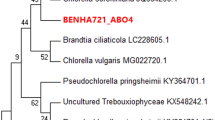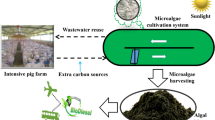Abstract
Brewery effluent (BE) as an appreciable and sustainable resource presented new possibilities in low-cost algal biomass production, whereas the relatively low essential macronutrients hindered extensive applications as growth medium for microalgae cultivation. The objective of this study was to investigate the feasibility of an integrated treatment strategy initiated by BE coupling phytohormones in augmenting biomass and lipid accumulation in Coccomyxa subellipsoidea. Results revealed that BE coupling synthetic 1-naphthaleneacetic acid (NAA) accomplished the favorable lipid productivity of 481.76 mg/L/days, representing 6.80- to 9.71-fold more than that of single BE as well as standard Basal media. BE coupling NAA feeding also heightened the proportions of C16–C18 fatty acids (over 96%) and mono-unsaturated C18:1 (approximate 45%) which were prone to high-quality biofuels-making. Such profound lipids accumulation might be attributable to that BE coupling NAA treatment drove most of metabolic flux (i.e. acetyl-CoA) derived from TCA cycle and glycolysis flowing into lipid accumulation pathway. Concurrently, the complete removal of total nitrogen and total phosphorus by C. subellipsoidea with assistance of NAA were easily complied with the permissible dischargeable limits for BE. These present results strongly demonstrated that BE coupling NAA was a potential feeding strategy in boosting algal lipid productivity and further provided great possibilities in linking affordable algal biomass production with high-efficient biological contaminants removal.




Similar content being viewed by others
References
Allen JW, DiRusso CC, Black PN (2015) Triacylglycerol synthesis during nitrogen stress involves the prokaryotic lipid synthesis pathway and acyl chain remodeling in the microalgae Coccomyxa subellipsoidea. Algal Res 10:110–120
Choi HJ (2016) Parametric study of brewery wastewater effluent treatment using Chlorella vulgaris. Environ Eng Res 21:401–408
Ebrahimian A, Kariminia HR, Vosoughi M (2014) Lipid production in mixotrophic cultivation of Chlorella vulgaris in a mixture of primary and secondary municipal wastewater. Renew Energy 71:502–508
Farooq W, Lee YC, Ryu BG, Kim BH, Kim HS, Choi YE, Yang JW (2013) Two-stage cultivation of two Chlorella sp. strains by simultaneous treatment of brewery wastewater and maximizing lipid productivity. Bioresour Technol 312:230–238
Ji Y, Hua WR, Li XQ, Ma GX, Song MM, Pei HY (2014) Mixotrophic growth and biochemical analysis of Chlorella vulgaris cultivated with diluted monosodium glutamate wastewater. Bioresour Technol 152:471–476
Jusoh M, Loh SH, Chuah TS, Aziz A, Cha TS (2015) Elucidating the role of jasmonic acid in oil accumulation, fatty acid composition and gene expression in Chlorella vulgaris (Trebouxiophyceae) during early stationary growth phase. Algal Res 9:14–20
Klein BC, Bonomi A, Filho RM (2018) Integration of microalgae production with industrial biofuel facilities: a critical review. Renew Sust Energ Rev 82:1376–1392
Knothe G, Matheaus AC, Iii TWR (2003) Cetane numbers of branched and straight-chain fatty esters determined in an ignition quality tester. Fuel 82:971–975
Kothari R, Pathak VV, Kumar V, Singh DP (2012) Experimental study for growth potential of unicellular alga Chlorella pyrenoidosa on dairy wastewater: an integrated approach for treatment and biofuel production. Bioresour Technol 116:466–470
Liu TT, Liu F, Wang C, Wang ZY, Li YQ (2017) The boosted biomass and lipid accumulation in Chlorella vulgaris by supplementation of synthetic phytohormone analogs. Bioresour Technol 232:44–52
Lu YD, Xu J (2015) Phytohormones in microalgae: a new opportunity for microalgal biotechnology? Trends Plant Sci 20:273–282
Lutzu GA, Zhang W, Liu TZ (2016) Feasibility of using brewery wastewater for biodiesel production and nutrient removal by Scenedesmus dimorphus. Environ Technol 37:1568–1581
Markou G, Vandamme D, Muylaert K (2014) Microalgal and cyanobacterial cultivation: the supply of nutrients. Water Res 65:186–202
Mata TM, Melo AC, Meireles S, Mendes AM, Martins AA, Caetano NS (2013) Potential of microalgae Scenedesmus obliquus grown in brewery wastewater for biodiesel production. Chem Eng Trans 32:901–906
Mata TM, Santos J, Mendes AM, Caetano NS, Martins AA (2014) Sustainability evaluation of biodiesel production from microalgae Chlamydomonas sp. grown in brewery wastewater. Chem Eng Trans 37:823–828
Msanne J, Xu D, Konda AR, Casas-Mollano JA, Awada T, Cahoon EB, Cerutti H (2012) Metabolic and gene expression changes triggered by nitrogen deprivation in the photoautotrophically grown microalgae Chlamydomonas reinhardtii and Coccomyxa sp. C-169. Phytochemistry 75:50–59
Raposo MFDJ, Oliveira SE, Castro PM, Bandarra NM, Morais RM (2010) On the utilization of microalgae for brewery effluent treatment and possible applications of the produced biomass. J Inst Brew 116:285–292
Schneider T, Graeff-Hönninger S, French WT, Hernandez R, Merkta N, Claupein W, Hetrick W, Pham P (2013) Lipid and carotenoid production by olagineous red yeast Rhodotorula glutinis cultivated on brewery effluents. Energy 61:34–43
Su YJ, Song KH, Zhang PD, Su YQ, Cheng J, Chen X (2017) Progress of microalgae biofuel’s commercialization. Renew Sust Energ Rev 74:402–411
Subramaniyam V, Subashchandrabose SR, Ganeshkumar V, Thavamani P, Chen Z, Naidu R, Megharaj M (2016) Cultivation of Chlorella on brewery wastewater and nano-particle biosynthesis by its biomass. Bioresour Technol 211:698–703
Wang Y, Guo W, Yen H, Ho S, Lo Y, Cheng C, Ren N, Chang J (2015) Cultivation of Chlorella vulgaris JSC-6 with swine wastewater for simultaneous nutrient/COD removal and carbohydrate production. Bioresour Technol 198:619–625
Wang Y, Ho SH, Cheng CL, Guo WQ, Nagarajan D, Ren NQ, Lee DJ, Chang JS (2016) Perspectives on the feasibility of using microalgae for industrial wastewater treatment. Bioresour Technol 222:485–497
Woertz I, Feffer A, Lundquist T, Nelson Y (2009) Algae grown on dairy and municipal wastewater for simultaneous nutrient removal and lipid production for biofuel feedstock. J Environ Eng 135:1115–1122
Wu YH, Hu HY, Yu Y, Zhang TY, Zhu SF, Zhuang LL, Zhang X, Lu Y (2014) Microalgal species for sustainable biomass/lipid production using wastewater as resource: a review. Renew Sust Energ Rev 33:675–688
Zhu L, Wang Z, Shu Q, Takala J, Hiltunen E, Feng P, Yuan Z (2013) Nutrient removal and biodiesel production by integration of freshwater algae cultivation with piggery wastewater treatment. Water Res 47:4294–4302
Acknowledgements
This work was supported by National Natural Science Foundation of China (21676228) and Scientific Research Fund of Hunan Provincial Education Department (16B254), Hunan Provincial Natural Science Foundation of China (2017JJ3300), and Collaborative Innovation Center of New Chemical Technologies for Environmental Benignity and Efficient Resource Utilization.
Author information
Authors and Affiliations
Corresponding author
Rights and permissions
About this article
Cite this article
Liu, T., Luo, F., Wang, Z. et al. The enhanced biomass and lipid accumulation in Coccomyxa subellipsoidea with an integrated treatment strategy initiated by brewery effluent and phytohormones. World J Microbiol Biotechnol 34, 25 (2018). https://doi.org/10.1007/s11274-018-2408-9
Received:
Accepted:
Published:
DOI: https://doi.org/10.1007/s11274-018-2408-9




